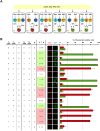Implementation of Complex Biological Logic Circuits Using Spatially Distributed Multicellular Consortia
- PMID: 26829588
- PMCID: PMC4734778
- DOI: 10.1371/journal.pcbi.1004685
Implementation of Complex Biological Logic Circuits Using Spatially Distributed Multicellular Consortia
Abstract
Engineered synthetic biological devices have been designed to perform a variety of functions from sensing molecules and bioremediation to energy production and biomedicine. Notwithstanding, a major limitation of in vivo circuit implementation is the constraint associated to the use of standard methodologies for circuit design. Thus, future success of these devices depends on obtaining circuits with scalable complexity and reusable parts. Here we show how to build complex computational devices using multicellular consortia and space as key computational elements. This spatial modular design grants scalability since its general architecture is independent of the circuit's complexity, minimizes wiring requirements and allows component reusability with minimal genetic engineering. The potential use of this approach is demonstrated by implementation of complex logical functions with up to six inputs, thus demonstrating the scalability and flexibility of this method. The potential implications of our results are outlined.
Conflict of interest statement
The authors have declared that no competing interests exist.
Figures





References
-
- Bray D (1995) Protein molecules as computational elements in living cells. Nature 376: 307–312. - PubMed
-
- Amos Martyn (2004) Cellular Computing. Oxford University Press, USA.
Publication types
MeSH terms
LinkOut - more resources
Full Text Sources
Other Literature Sources

